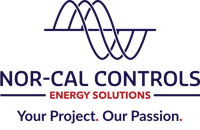Retrofitting is the process of modifying or replacing an existing SCADA system within a solar PV plant to fit the new or changing needs of a site. Over the lifetime of a solar PV plant, the plant's needs will evolve due to changing energy regulations, infrastructure upgrades, and more. The SCADA hardware and software will wear out or become antiquated, requiring upgrades in order to maintain efficiency and effectiveness.
Aging systems can suffer from numerous issues including:
- Outdated or lost documentation
- Limited availability/obsolescence/end-of-life of parts
- Lack of O&M/technical support
- Performance degradation, including breakdowns and longer downtimes
Mitigating these issues is inevitable and necessary to keep the SCADA system doing its job. Using an open architecture SCADA solution simplifies the retrofit process and can make it much more cost-effective.
FIRST, what is an open architecture SCADA system?
Open architecture SCADA systems are based on the following:
- Equipment is universally serviceable and maintainable, with no proprietary/special tools required
- Technical training is readily available
- Engineering and technical support are readily available
- Manuals and drawings are readily available
- End users or their designated O&M company receive direct support from the manufacturer
- Annual access fees and licensing fees of proprietary systems can be avoided
- Upgrades and enhancements are easier and less expensive, which means lower costs over the long term
1. What are the differences between a SCADA system migration and retrofit? What is a "rip and replacement"?
SCADA System Migration
SCADA system migration involves upgrading the existing system's hardware/software, while preserving much of the system's original design configuration and control strategies.
Potential benefits of migration can include:
- Minimized time, cost, and risk
- Reduced downtime during hardware and software platform upgrades, as the existing PLC code remains intact
Although new and consistent programming standards won't be fully applied using this approach, the overall functionality remains as close to original as possible, and the program can be improved to some extent.
SCADA System Retrofits
Retrofitting is the practice of upgrading old system components with new components, in order to add additional capabilities or functionality to the existing system. A retrofit uses as much of the existing hardware and infrastructure as possible, saving money on hardware.
Potential benefits of retrofitting can include:
- Improved system performance
- Better energy efficiency from new components
- Smaller footprint and more available panel space (newer components are typically more compact in size)
- Less expensive repairs due to availability of parts and supportability of components
"Rip and Replacement"
When system migration or retrofitting is not viable, the only option available is a "rip and replacement." This essentially means discarding the existing system and installing a new one from scratch.
A rip and replacement is oftentimes the most expensive option due to all of the new hardware and equipment costs. There are times, however, when it may be more cost-effective or at least much easier to start over with a new system than to try to make an old system work. Learn more about retrofits versus replacements in this article.
2. Why would an asset owner consider retrofitting an existing SCADA system?
Retrofits are common throughout the lifespan of a solar PV site. There are numerous reasons asset owners may consider retrofitting their SCADA system:
- Outdated hardware/software: The existing SCADA system hardware/software may be nearing end-of-life/obsolescence.
- Lack of O&M/technical support: The vendor may have undergone a merger/acquisition with little to no guarantee of supply of key components and technical support. Or, the asset owner may have lost the technical personnel capable of maintaining the now antiquated systems.
- Change of O&M vendor: The new O&M provider may have specific requirements for the HMI or need different control capabilities for the site.
- Site infrastructure changes: Changes to inverters or capacity to the site may require a retrofit. This typically involves modifying the HMI to add the additional power blocks, as well as extra networking equipment to handle the increased capacity.
- Addition of an Energy Storage System (ESS): The addition of battery storage to a site may require a more in-depth SCADA system retrofit. The control logic — and potentially the whole Power Plant Controller (PPC) — must be modified or replaced or added to accommodate those changes.
- Need of additional functionality on existing proprietary SCADA system: Proprietary SCADA systems may offer limited maintainability due to the proprietary tools required.
3. How are open architecture SCADA solutions simpler to retrofit compared to proprietary systems? Can using an open architecture SCADA system help prevent costly rip and replacements?
Proprietary systems are typically locked, and often require special tools and password protected credentials to work on them. If the OEM SCADA provider stops supporting the solution, there is often little choice but to rip and replace components or sometimes even the entire SCADA system.
Open architecture SCADA systems, on the other hand, are designed to offer better flexibility, scalability, and ease of operability. Using an open architecture SCADA system can help prevent costly rip and replacements for following reasons:
- The system will be open (unlocked) to work with almost any third-party software or hardware automation system
- They use off-the-shelf components that are available on the open market for easier upgrades/changes
- They allow for immense flexibility in hardware choices and are bolt-on compatible, making it easy to add/change components
- It's easier to integrate new devices into the base SCADA system because the open architecture allows it to accept third-party communications
- Components are open (unlocked) and don't require special tools to work on them
- More SCADA integrators and O&M vendors can work on them, providing more support options
We build and recommend open architecture systems based on established OEMs like GE/Emerson and Rockwell Automation. They have been around for more than a century and will continue to be in business, developing and supporting their equipment and software indefinitely. Each of their product lines have a migration path for at least 25 years and OEM and integrator support is always easily accessible.
4. What are some additional benefits of an open architecture SCADA system for the asset owner?
In addition to scalability, the primary benefit of an open architecture SCADA system is the long term cost savings over time. Unlike most proprietary systems, there are no annual, ongoing data access fees and licensing fees. There are no restrictive service agreements for troubleshooting support, maintenance, logic modifications, and enhancements. This opens up competition for O&M bids.
Learn more: Advantages of Open Architecture SCADA Solutions
Reduce SCADA Costs With Intelligent Site Design
5. How does an open architecture SCADA solution help ease the burden on O&M teams during and after a retrofitting process?
O&M teams are vital to keeping a solar PV site functioning and producing as it should. A system retrofit can disrupt that if the team must adapt to unfamiliar equipment and processes, and/or if it's difficult to get the training and support they need.
Open architecture SCADA systems based on established OEMs have these advantages for O&M teams:
- Team members are more likely to be familiar or have worked with the replacement components, shortening the learning curve
- Training is easier on existing equipment or on equipment that has a similar user interface
- It is easier to find and hire new operators and techs who have experience with the equipment
- Equipment is universally serviceable and maintainable without the need for proprietary tools
- It is easier to customize the system to fit specific operator needs and preferences (ex. HMI graphics)
- Standardization is easier, include spare parts replacement
- There are plenty of resources for support, including direct OEM support, engineering support, manuals, drawings, and training
Asset owners also benefit from the ease of support, which improves efficiency and lowers operating costs.
6. What considerations should be kept in mind regarding hardware when retrofitting an open architecture SCADA solution?
It is important to communicate to the SCADA engineering team the new hardware requirements and the desired results of the retrofit. It is easier in most cases to retrofit open architecture solution components on the existing SCADA rack, but it can still be a complex process.
It is advisable to share photos of the existing rack and other hardware with the team so that they can assess what's available at the site and suggest solutions. The asset owner should provide as many details as possible for the following hardware and equipment:
- Servers (SCADA and/or historian)
- Power Plant Controller (PPC)
- Network switches
- HMI
- Field communication network components
- Substation IEDs (intelligent electronic devices)
- MET station components
- Availability of space on the existing rack
7. What considerations should be kept in mind regarding software when retrofitting an open architecture SCADA solution?
As with the hardware retrofit, the engineering team will need to know the requirements and intended results in order to recommend a solution and a suitable execution plan. They will need as much information as possible about the following:
- SCADA/Historian/HMI software
- Kepware software (if applicable)
- Modbus mapping of field components
- Communication protocols used at the site (Modbus, DNP3, etc.)
How can Nor-Cal Controls help support a solar PV SCADA retrofit project?
As a leading SCADA integrator within renewables, our engineers are well versed across most platforms and are highly adaptable when it comes to different types of retrofit projects. Rather than go right to recommending a rip and replace, we can work with existing software, hardware, and equipment to add or restore system functionality.
Our open architecture SCADA systems are also designed for adaptability. They are bolt-on compatible, meaning they scale easily by adding, upgrading, or swapping components.
If you have a solar PV retrofit project, or a new project that you want built with future adaptability in mind, we’d be happy to discuss different options and opportunities. Schedule a call with us today.





